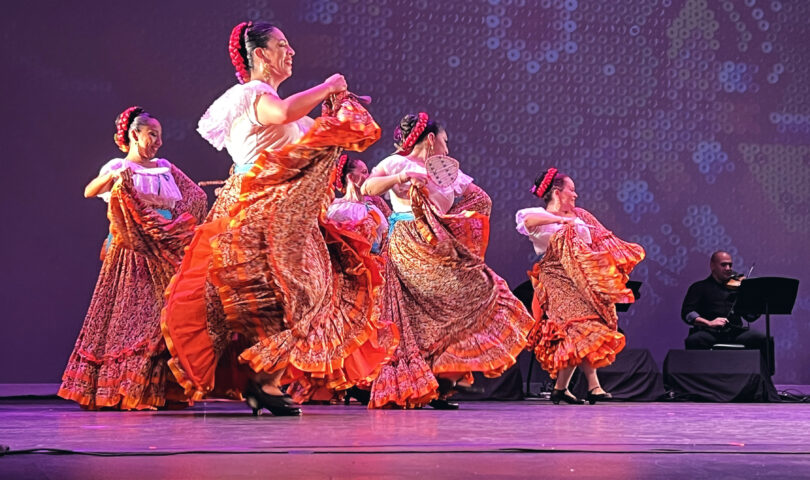On Saturday, Oct. 7, the Calpulli Mexican Dance Company (CMDC) performed in the Sharp Theatre at the Berrie Center. Founded in 2003, CMDC’s mission is to celebrate Mexican cultural heritage through dance. The focus of their performance was to demonstrate dances from five different regions of Mexico in order to teach audiences that mariachi and the jarabe tapatío, or Mexican Hat Dance, aren’t the only dances.
The day before this performance, a couple classes were invited to an information session hosted by Grisel Pren Monje, the artistic director for CMDC, and Yisel Xique, a teaching artist assistant.
They started the session by discussing Día de los Muertos, or The Day of the Dead. This holiday is a chance to celebrate ancestors by honoring their legacy. People will set up ofrendas, altars to loved ones, and display offerings of their favorite foods, things they enjoyed and flowers. Cempasúchiles or marigolds are commonly used due to their bright color and strong aroma being able to guide the departed.
So much work is put into these performances and they are beautifully educational. I’m feeling extremely grateful that I had the opportunity to see them live.
“We do feel sorry for the departed… but we celebrate them. For us, they don’t die and they disappear, they just move from one life to a different life,” Monje explained.
After this, Monje and Xique took a moment to perform a short dance before inviting the attendees to learn the jarabe tapatío. The room was split in half with two groups of students and faculty per performer as we mimicked the steps. It was a lot of fun to learn, as someone who doesn’t dance much aside from awkward flailing.
This session was just the build-up to this amazing performance. On stage there were live musicians accompanying the dancers. Behind them, the screen depicted various images throughout the night denoting the change in region, switching from a floral scene to one of cacti, and at one point changing to a painting called “The Flower Carrier” by Diego Rivera.
The performers would also change costumes in between scenes. The show began with the women wearing flowing white dresses with white lace draped over their shoulders and a black waist apron with embroidered purple flowers. Meanwhile, the men wore white button up shirts, black pants, a small red scarf and white hats.
One of the dances featured in this region involved the women placing unlit candles on their heads and balancing them as they moved around the stage. Their caution as they took smaller steps and made slower sweeping motions was impeccable.
The following region featured women in purple skirts with white lace and blouses. The men traded out their white clothing for black vests and hats as they pulled the ladies into a dance. This section relied on coordination as four dance pairings had to mimic each other in opposite directions.
The next region featured another balancing dance, only this time talented performers Juan Castaño and Adina Lopez balanced tequila bottles on their heads. Lopez wore an orange skirt speckled with white flowers and a white blouse with a little green ribbon at the top. Castaño wore a loose-fitting collared purple shirt with black pants and a red scarf.
Afterwards, a featured dance included a male performer with a gabán, or thin woven poncho, wrapped around his shoulders following a female performer wearing a bright red skirt with green and white accents. The idea of the dance was to show a connection through a courting performance, with the man matching the movements of the woman in long strides.
Finally, the last dance of the night featured men dancing with machetes. They lined up at the front of the stage kicking and stomping while clanging machetes under their legs and over their heads. The performance was breathtaking. At one point, they had to clash machetes with another performer and then toss their machetes to one another. The precision at which these performers tossed and caught their machetes was astounding.
Overall, it was clear to see the overwhelming passion CMDC has for what they do. So much work is put into these performances and they are beautifully educational. I’m feeling extremely grateful that I had the opportunity to see them live. You can follow what they are doing next on their website, so take a moment to check them out.
pbortner@ramapo.edu
Featured photo by Peyton Bortner






